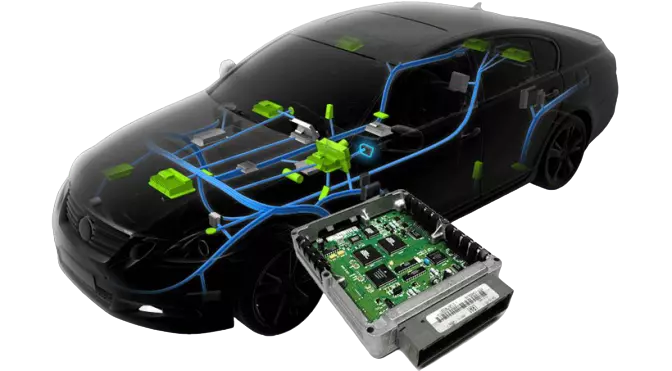Your car’s body control unit (BCM) is not the same as the engine control module. Instead, it controls and connects the many systems unrelated to your vehicle’s engine. These include lighting, central locking, windows, air conditioning and windshield wipers. Symptoms of a bad body control unit include failure of electrical systems such as central locking, windows, wipers and lights. It can also lead to battery drain, a car that won’t start, a problem with the in-car entertainment system, and will usually cause the check engine light to come on.
It can be difficult to diagnose a failing body control unit, especially when the symptoms are intermittent and varied. If your motor vehicle has any of the above issues, I would recommend performing a diagnostic check to see if there are any errors stored in the body control module memory. The most common error code associated with a failure of the body control module is U0140. In this article, I will go over the various symptoms of a failing body control unit, how to diagnose and fix the problem; and how much it will likely cost.
What are the symptoms of a faulty body control module?
The body control module is one of the three main control units in your vehicle. It essentially controls most of the auxiliary systems in your vehicle, which are not associated with the transmission or the engine. If it is damaged or starts to fail, it can create a host of sometimes intermittent symptoms and often leave you scratching your head. If the body control unit fails completely, it is much easier to diagnose, as the powertrain control module will normally detect the failure if it can no longer communicate with it. Here are some of the most common signs of a broken body control unit:
1. Warning lights on the instrument panel
If the body control module cannot communicate with systems such as the anti-lock braking module (ABS), airbag control module, or power train control module, it will not be able to verify that they are working. correctly. This can lead to flashing lights on the dashboard due to perceived issues with the various systems it can no longer communicate with. In this case, it can be quite easy to diagnose a problem with the body control module, as your vehicle is unlikely to suffer from a failure of multiple systems at the same time. It is more likely to be a problem with the body control module or the Controller Area Network (CAN) bus system.

It may not be obvious at first where the problem is, and you may need to check each system individually to make sure it is working, and that it is in fact a communication error that is causing the LEDs. . In some cases, the problem may be with the CAN bus communication network, and you may experience the error code U0001. In this case, there may be a short in the system caused by corroded wiring or damage to the wire harness. It can also be caused by a faulty Fully Integrated Power Module (TIPM).
2. Failure of the central locking system or the security system
A fault in the body control module will cause problems with the operation of one or more of the systems it controls. The first sign of a problem may be when you are going to unlock the car. Central locking may fail or keyless access if installed may not work. You may also not be able to turn off the alarm or the immobilizer. Before diagnosing a problem with the body control unit, you will need to eliminate the issues with the central locking and other affected systems. You may need to get help from an auto electrician as these issues can be caused by multiple faulty modules.
3. The engine does not start
In order for the engine to start, the key must engage the ignition and send a signal to the starter motor to start the vehicle. The ignition is usually controlled by the body control module, so any issues with it can result in a vehicle not starting. When you turn the ignition key or press the engine start button, the body control unit checks that the correct key is in the ignition (or in your pocket if your vehicle has a wireless key). intelligent). The key ID must match the ID stored in the body control module for the engine to start. If there are communication problems between the ignition switch or keyless entry receiver and the BCM,
4. The battery continues to drain
A short or faulty circuit board in the body control module can drain the vehicle’s battery. This can be caused by what is called a parasitic drain, when too much current is used by a system controlled by the body’s control module. The body control module controls all kinds of electrical systems, from lights and parking sensors to vehicle alarm systems. A failure of the body control module can leave electrical components energized when they need to be turned off. This can drain the battery when the engine is stopped or if the vehicle is left parked overnight.
An example of this is the interior lighting which does not turn off when the car is locked, or the radio which remains on when the ignition is off.
5. Electrical systems are not working as they should (or intermittently)
The body control unit facilitates the operation of most of a vehicle’s electrical systems. Problems with this control unit may manifest as problems with one or more of these auxiliary components. If the body control unit is still operating and has not registered any fault codes with the power train module, it may be difficult to find the cause of the problem. It is often necessary and easier to replace the control unit with a new or refurbished unit to see if it fixes the problem.
It is not uncommon for a bad body control unit to cause intermittent faults with components such as power windows, headlights, central locking, main units, door locks, windshield wipers, etc. instrumentation of the dashboard, horn, parking sensors and interior lighting.
How do I repair a vehicle body control module?
It is usually not possible to repair a body control module at home. Most of the time, a faulty body control module is caused by module failure or failure and will require professional repair or overhaul. It is usually cheaper to simply replace the unit with a new module or a refurbished module. The physical replacement of a body control module is not difficult, it usually involves a few electrical connectors and retaining bolts. The “hard” part is programming the new unit on the vehicle. Unless you have the right equipment, it doesn’t
With some older motor vehicles, with less complicated electrical systems, you may be able to replace a broken BCM with a used one from a salvage yard or online auction site. This will only work if the body control module being used is the same as the one you are replacing and has the same serial numbers.
How much does it cost to replace a bad body control module?
A new body control module can cost anywhere from $ 150 to $ 2000 or more. It all depends on the motor vehicle model, the age of the vehicle, and whether or not the body control module can be replaced independently of the power train control module.
READ MORE : What Does The Tire Pressure Sensor Fault And How To Fix It?


1 thought on “Symptoms of Bad Body Control Module”